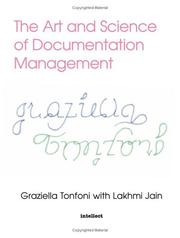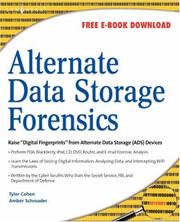| Listing 1 - 10 of 302 | << page >> |
Sort by
|
Periodical
Year: 1999 Publisher: Boynton Beach, Fla. : Worldwide Videotex,
Abstract | Keywords | Export | Availability | Bookmark
 Loading...
Loading...Choose an application
- Reference Manager
- EndNote
- RefWorks (Direct export to RefWorks)

ISBN: 1841508756 9781841508757 9786610476688 6610476683 1841500720 9781841500720 1280476680 9781280476686 9781841508756 Year: 2003 Publisher: Bristol, UK : Intellect Books,
Abstract | Keywords | Export | Availability | Bookmark
 Loading...
Loading...Choose an application
- Reference Manager
- EndNote
- RefWorks (Direct export to RefWorks)
As information becomes increasingly accessible through newly-introduced technologies, the human mind seeks a more comprehensive interpretation of the world in which we live. In order to manage this information overload, we must carefully reconsider our attitude towards documentation. While acknowledging the value of the standard guidebooks' hard rules on documentation management, Tonfoni advocates a new approach that promotes additional skills required for consistent decision-making, such as information sensitivity. This book has been conceived as a movie on paper, and as such, can be consider
Records --- Information storage and retrieval systems. --- Management.

ISBN: 9781597491631 1597491632 9780080554754 008055475X 1281077097 9781281077097 9786611077099 Year: 2007 Publisher: Oxford Elsevier Science [distributor]
Abstract | Keywords | Export | Availability | Bookmark
 Loading...
Loading...Choose an application
- Reference Manager
- EndNote
- RefWorks (Direct export to RefWorks)
Learn to pull "digital fingerprints? from alternate data storage (ADS) devices including: iPod, Xbox, digital cameras and more from the cyber sleuths who train the Secret Service, FBI, and Department of Defense in bleeding edge digital forensics techniques. This book sets a new forensic methodology standard for investigators to use.This book begins by describing how alternate data storage devices are used to both move and hide data. From here a series of case studies using bleeding edge forensic analysis tools demonstrate to readers how to perform forensic investigations on a variety of AD
Periodical
Abstract | Keywords | Export | Availability | Bookmark
 Loading...
Loading...Choose an application
- Reference Manager
- EndNote
- RefWorks (Direct export to RefWorks)
Book
Year: 2017 Publisher: Birmingham : Packt,
Abstract | Keywords | Export | Availability | Bookmark
 Loading...
Loading...Choose an application
- Reference Manager
- EndNote
- RefWorks (Direct export to RefWorks)
Deep dive into the unified, distributed storage system in order to provide excellent performance About This Book Leverage Ceph's advanced features such as erasure coding, tiering, and Bluestore Solve large-scale problems with Ceph as a tool by understanding its strengths and weaknesses to develop the best solutions A practical guide that covers engaging use cases to help you use advanced features of Ceph effectively Who This Book Is For If you are a developer and an administrator who has deployed a Ceph cluster before and are curious about some of the most advanced features in order to improve performance then this book is for you What You Will Learn Know when and how to use some of Ceph's advanced new features Set up a test cluster with Ansible and some virtual machines using VirtualBox and Vagrant Develop novel solutions to massive problems with librados and shared object classes. Choose intelligent parameters for an erasure coded pool and set it up. Configure the Bluestore settings and see how they interact with different hardware configurations. Keep Ceph running through thick and thin with tuning, monitoring and disaster recovery advice. In Detail Mastering Ceph covers all that you need to know to use Ceph effectively. Starting with design goals and planning steps that should be undertaken to ensure successful deployments, you will be guided through to setting up and deploying the Ceph cluster, with the help of orchestration tools. Key areas of Ceph including Bluestore, Erasure coding and cache tiering will be covered with help of examples. Development of applications which use Librados and Distributed computations with shared object classes are also covered. A section on tuning will take you through the process of optimisizing both Ceph and its supporting infrastructure. Finally, you will learn to troubleshoot issues and handle various scenarios where Ceph is likely not to recover on its own. By the end of the book, you will be able to successfully deploy and operate a resilient high performance Ceph cluster. Style and Approach A practical guide which has each chapter explaining the concept, sharing tips and tricks and a use case to implement the most powerful features of Ceph
Book
ISBN: 0429185103 1283596296 9786613908742 1439891990 Year: 2012 Publisher: Boca Raton, FL : CRC Press, Taylor & Francis Group,
Abstract | Keywords | Export | Availability | Bookmark
 Loading...
Loading...Choose an application
- Reference Manager
- EndNote
- RefWorks (Direct export to RefWorks)
Information retrieval (IR) is the area of study concerned with searching for documents, information within documents, and metadata about documents, as well as searching relational databases and the World Wide Web. This book covers the management, types, and technical standards of these increasingly important systems. It discusses all types of information retrieval systems, including those used in medicine, geographic information, and music, as well as retrieval in computer-supported collaborative work, Web mining, social mining, and the Semantic Web. Library and museum IR systems are also covered. Leading contributors in the field address digital asset management, piracy in digital media, records compliance, information storage technologies, and data transmission protocols-- Understanding Information Retrieval Systems: Management, Types, and Standards Marcia J. Bates, Editor INTRODUCTION Information retrieval systems, especially those accessed over the Internet, are ubiquitous in our globalizing world. Many are wonderfully easy to use, and it is therefore easy to assume that the design and implementation of information systems is a simple and straightforward process. However, systems need to be designed specifically for their intended functions in order to provide optimal support for the people who use them. It turns out that it is not always obvious what needs to be done to produce a really well-functioning information system. In addition, information systems are almost always part of a much larger infrastructure that is designed to support business, government, and other activities. All parts of that infrastructure need to mesh into a single well-functioning social and technical system, containing and optimizing the information systems within. Consequently, information systems are seldom stand-alone. They need to be made interoperable with other systems of many types, and at many levels of functionality. In this volume are gathered together articles on different types of information systems, on managing information systems, both as collections of data and as part of a larger social and administrative system, and on the technical standards that are required in order for the systems to inter-operate with other systems and networks. World Wide Web-based systems are emphasized. Collectively, the articles in this book provide an excellent introduction to the various aspects of developing and managing information retrieval systems in the context of real-world demands--
Book
ISBN: 0128034645 0128034556 9780128034644 9780128034552 Year: 2016 Publisher: Amsterdam, [Netherlands] : Elsevier,
Abstract | Keywords | Export | Availability | Bookmark
 Loading...
Loading...Choose an application
- Reference Manager
- EndNote
- RefWorks (Direct export to RefWorks)
Text summarization has been studied for over a half century, but traditional methods process texts empirically and neglect the fundamental characteristics and principles of language use and understanding. Automatic summarization is a desirable technique for processing big data. This reference summarizes previous text summarization approaches in a multi-dimensional category space, introduces a multi-dimensional methodology for research and development, unveils the basic characteristics and principles of language use and understanding, investigates some fundamental mechanisms of summarization, studies dimensions on representations, and proposes a multi-dimensional evaluation mechanism. Investigation extends to incorporating pictures into summary and to the summarization of videos, graphs and pictures, and converges to a general summarization method. Further, some basic behaviors of summarization are studied in the complex cyber-physical-social space. Finally, a creative summarization mechanism is proposed as an effort toward the creative summarization of things, which is an open process of interactions among physical objects, data, people, and systems in cyber-physical-social space through a multi-dimensional lens of semantic computing. The author’s insights can inspire research and development of many computing areas. The first book that proposes the method for the summarization of things in cyber-physical society through a multi-dimensional lens of semantic computing. A transformation from the traditional application-driven research paradigm into a data-driven research paradigm for creative summarization through information modeling, cognitive modeling and knowledge modeling. A multi-dimensional methodology for studying, managing, creating and applying methods.
Automatic abstracting. --- Abstracting --- Information storage and retrieval systems
Book
ISBN: 0081012055 178548091X 9780081012055 9781785480911 Year: 2016 Publisher: London, [England] ; Oxford, [England] : ISTE Press : Elsevier,
Abstract | Keywords | Export | Availability | Bookmark
 Loading...
Loading...Choose an application
- Reference Manager
- EndNote
- RefWorks (Direct export to RefWorks)
Information storage and retrieval systems --- Medicine. --- Medical informatics --- Medicine
Book
ISBN: 0857244639 0857244647 1282987097 9786612987090 Year: 2010 Publisher: [Bingley, UK] : Emerald,
Abstract | Keywords | Export | Availability | Bookmark
 Loading...
Loading...Choose an application
- Reference Manager
- EndNote
- RefWorks (Direct export to RefWorks)
This VINE e-book is to provide an additional resource to knowing and understanding cultures, both across the world, and in organizational settings within the same country or region. The authors hail from a variety of backgrounds and work experiences themselves. The common denominator is their intense involvement in the knowledge management arena, trying to develop principles and practices to leverage knowledge assets under their cognizance. The guest editors' wish is that the reader will take away a better appreciation of humankind, and how we all attempt to live and function in a shared world
Book
ISBN: 0857246011 085724602X 1282987232 9786612987236 Year: 2010 Publisher: [Bingley, UK] : Emerald,
Abstract | Keywords | Export | Availability | Bookmark
 Loading...
Loading...Choose an application
- Reference Manager
- EndNote
- RefWorks (Direct export to RefWorks)
There are many digital library developments taking place in China and neighbouring countries. This book includes perspectives from Peking University Library and Tsinghua University Library. Also a profile of consortia activity in China, and machine-readable cataloguing with Chinese characters.
Information storage and retrieval systems. --- Library science --- Data processing.
| Listing 1 - 10 of 302 | << page >> |
Sort by
|

 Search
Search Feedback
Feedback About UniCat
About UniCat  Help
Help News
News